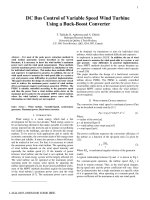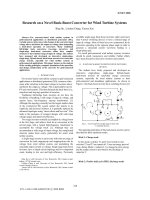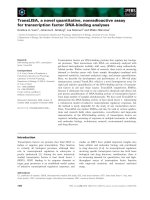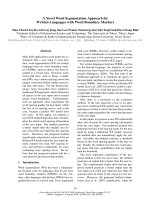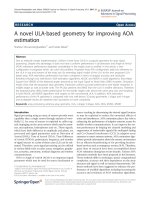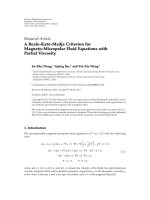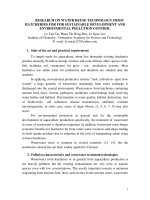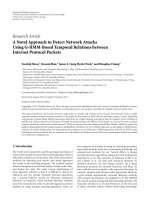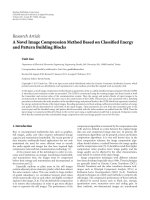Research on a novel buck boost converter for wind turbine systems
Bạn đang xem bản rút gọn của tài liệu. Xem và tải ngay bản đầy đủ của tài liệu tại đây (302.13 KB, 6 trang )
ICSET 2008
Abstract—For converter-based wind turbine systems in
grid-connected applications as distributed generators (DG),
variable sources often cause wide changes in the converter input
voltage above and below the output ac voltage, thus demanding
a buck-boost operation of converters. Many traditional
full-bridge buck converters, two-stage converters and
single-stage buck-boost converters either have complex
structure or have limited range of input dc voltage. The authors
have proposed and developed an innovative single-phase,
single-stage, flyback-based, buck-boost converter for renewable
energy systems, especially for wind turbine systems in
grid-connected applications. This paper focuses on the analysis
of the working principles, computer simulation of the operation,
and design consideration of the converter for grid-connected
applications.
I.
I
NTRODUCTION
For inverter-based wind turbine systems in grid-connected
applications as distributed generators (DG), resources often
cause wide variations in the input voltage to inverters above
and below the output ac voltage. This is particularly true for
PV and wind systems. This then demands the buck-boost (i.e.,
step-down and step-up) operation of inverters.
Traditional full-bridge buck inverters do not have the
flexibility of handling a wide range of input dc voltage, and
require heavy line-frequency step-up transformers [1].
Although this topology currently has the largest market share
of the commercial DG system market due mainly to its
simplicity and electrical isolation, it is gradually replaced by
advanced topologies using “more silicon and less iron”. This
leads to the pursuance of compact designs with wide input
voltage ranges and improved efficiency.
Two-stage inverters normally accomplish dc voltage boost
in the first stage, and achieve buck dc-ac conversion in the
second stage, with a typical high-frequency transformer to
accomplish the voltage boost [1]. Although they can
accommodate a wide range of input voltage, the complicated
structure makes them costly, particularly for small wind
turbine systems.
A single-stage inverter is an inverter with only one stage of
conversion for both stepping-up and stepping-down the dc
voltage from wind turbine sources and modulating the
sinusoidal output current or voltage. Single-stage buck-boost
inverters, have a simple circuit topology and low component
count, leading to low cost and high efficiency. Previously
Bing Hu is with University of New Brunswick, NB, Canada (e-mail:
hubing_1977@ hotmail.com)
Liuchen Chang is with University of New Brunswick, NB, Canada
(e-mail: lchang@ unb.ca).
Yaosuo Xue is with University of New Brunswick, NB, Canada (e-mail:
y.x@ unb.ca).
available single-stage buck-boost inverters either need more
than 4 power switching devices or have a limited range of
input dc voltage. Most of them have two symmetrical dc-dc
converters operating in the opposite phase angle in order to
generate a sinusoidal current waveform feeding to a
single-phase grid.
For small grid-connected wind turbine systems, inverters
should be small, inexpensive and reliable. Further efforts
have been directed to innovative inverters and controls.
II.
A
NEW BUCK
-
BOOST INVERTER WITH
4
SWITCHING
DEVICES
The Authors have firstly proposed and developed an
innovative single-phase, single-stage, flyback-based,
buck-boost inverter for renewable energy conversion
systems, especially for wind turbine systems in both
grid-connected and standalone applications. As shown in
Figure 1, this buck-boost inverter has 4 switching devices [2].
The operating principles of this buck-boost inverter can be
described by three operation modes.
Mode 1: Charge mode
In this mode, switches T1 and T4 are turned on and
switches T2 and T3 are turned off. From an energy point of
view, during Mode 1, inductor L1 is charged to store energy
and the output current is provided by the discharge of
capacitor C.
Mode 2: Positive half cycle (PHC) discharge mode
Research on a Novel Buck-Boost Converter for Wind Turbine Systems
Bing Hu, Liuchen Chang, Yaosuo Xue
Fig. 1. A new buck-boost single-stage inverter with
4 switchin
g devices.
228
978-1-4244-1888-6/08/$25.00
c
2008 IEEE
In this mode, switch T4 is turned off and T3 is turned on,
while T1 is keeping on and T2 off.In this mode, the dc source
is disconnected temporarily from the output
Two current conduction modes can be defined here. If the
time of Mode 2 is so short that the inductor current is not
decreasing to zero when the next charge cycle Mode 1 starts,
the current of energy-storage inductor is continuous, and we
define this operation the continuous conduction mode
(CCM). On the contrary, if the inductor current drops zero in
Mode 2 and probably sustains zero for certain time, the
operation is defined the discontinuous conduction mode
(DCM).
So far, in the PHC of ac output, the energy is transferred
from dc source (i.e. Wind Turbine) to ac grid through the
alternations of Mode 1 and Mode 2.
Mode 3: Negative half cycle (NHC) discharge mode
This mode is combined with Mode 1 to provide ac NHC
output when switch T1 is tuned off and T2 is turned on.
Through a flyback operation, the current of primary side of
the coupled inductor L drops to zero suddenly and the current
of secondary side reaches to the initial current of primary
side, if the inductances and turns of both sides of the coupled
inductor are identical and there is no magnetic leakage.
The only differences between Mode 3 and Mode 2 are that
in Mode 3, the grid is in the negative half cycle and the
discharging current has an opposite direction. Then similar
arguments regarding energy exchange and transfer in Mode 2
can be also applied to Mode 3. As a result, in the NHC of ac
output, the energy is transferred from dc source to ac grid
through L1, L2 and C by the alternations of Mode 1 and
Mode 3.
In summary, during each switching interval, the
energy-storage inductor is charged from a dc source (i.e.
Wind Turbine) and discharged to a grid through a low pass
filter. The inductor current can be discontinuous as shown
in Figure 2, and continuous as shown in Figure 3.
The simulation waveforms for the buck-boost inverter
subject to a variable dc voltage sources, controlled by an open
loop feedforward compensation [3], are shown in Figure 4.
The current total harmonic distortion (THD) of the 120V grid
side is 2% for a switching frequency of 9.6 kHz.
The simulation waveforms for the buck-boost inverter
subject to a variable dc voltage sources, controlled by a
closed-loop sinusoidal PWM modulation [3], are shown in
Figure 5. The current total harmonic distortion (THD) of the
120V grid side is 3.4% for a switching frequency of 9.6 kHz.
It is noted that the grid voltage has been assumed containing
significant harmonic contents.
Fig. 2. Buck-boost inverter operation in the discontinuous current mode.
Fig. 3. Buck-boost inverter operation in the continuous current mode.
Fig. 4. Simulated waveform of the buck-boost inverter under the
open loop feedforward compensation control.
229
III.
A
NEW BUCK
-
BOOST INVERTER WITH
3
SWITCHING
DEVICES
Based on the buck-boost inverter with 4 switching devices
as developed by the Authors for small distributed generators,
further improvements have been proposed, which leads to a
new buck-boost inverter with 3 switching devices [4]. This
inverter is shown in Figure 6. The simple circuit topology of
this invention provides the possibility for a low cost and high
efficiency dc-ac converter appropriate for small wind turbine
applications. The inverter has a low component count with
only 3 power semiconductor switches to accomplish dc-ac
conversion.
The inverters can accommodate a wide range of input dc
voltage for an improved energy output from variable wind
turbine resources. The input source and the output grid are
separated based on flyback operation principles. As
compared to traditional buck inverters with line-frequency
transformers, two-stage buck-boost inverters, and other
single-stage buck-boost inverters, both the component count,
cost and size of the newly proposed buck-boost inverter are
reduced, thereby presenting a more reliable and economical
design for wind turbine systems and other distributed
generators.
The two coupled inductors L
1
and L
2
have the same
inductance L. Since only one switch is turned on in each
operation mode and an inductor is always connected in the
charge/discharge circuit, the dead time for preventing two
switches from shoot-through can be eliminated. The inverter
operation can be divided into charge and discharge operation
working in the positive half cycle and in negative half cycle,
similar to the buck-boost inverter with 4 switching devices, as
presented in the previous section.
Mode 1: Charge mode
During Mode 1, switches
2
Q
and
3
Q
are turned off, and
switch
1
Q
is turned on to charge inductor
1
L
from the dc
source through diode
1
D
. Capacitor C provides the
continuous current for the grid in Mode 1. The governing
equations are the same as in Mode 1 of the 4-switch
buck-boost inverter.
Mode 2: Positive half cycle (PHC) discharge mode
Mode 2 is the discharge mode in positive half cycle. During
Mode 2, switches
1
Q
and
3
Q
are turned off, and switch
2
Q
is turned on to discharge the energy, which was stored in
inductor
1
L
, to the grid through diode
2
D
. Figure 7 is the
operation waveforms in a positive half cycle.
I(Q1)
I(Q2)
Iout1
Ich+
Idisch+
Ich+
Idisch+
Idisch+
Q2
Q1
D1
D2
ON
ON
ON
ON ON
ON
ON
ON
t1t0
I(L1)
Mode 3: Negative half cycle (NHC) discharge mode
Mode 3 follows Mode 1 in a negative half cycle of the grid
voltage. During Mode 3, switches
1
Q
and
2
Q
are turned off,
and switch
3
Q
is turned on. The energy which is stored in the
coupled inductor
1
L
will transfer to the coupled inductor
2
L
and then discharges to the load through switch
3
Q
and
diode
3
D
. Figure 8 is the operation waveforms in a negative
half cycle.
Assume that the resistance of the switches, diodes, and
coupled inductors are negligible; two coupled inductors are
perfectly coupled; the inverter works in discontinue current
mode (DCM); the averaged current of Mode 2 is the average
output current of the inverter and can be expressed as,
Fig. 5. Simulated waveform of the buck-boost inverter under the
closed loop sinusoidal PWM control.
Fig. 6. Newly proposed buck-boost inverter with 3 switching
devices.
Fig. 7. Operation waveforms in a positive half cycle.
230
³
===
−
2
0
grids
2
1
grids
2
1
2
dc
11
22
1
T
s
VT
LI
VLT
TV
dti
T
i
(1)
where,
grid
1
2
V
LI
T =
, and T
S
is the switching period.
It is assumed that the utility line voltage V
grid
is expressed
as a sinusoidal waveform:
)sin(2
grid
tVV
ω
=
(2)
One of the algorithms for sinusoidal PWM is to control the
turn-on time of switch Q
1
in proportion to the utility voltage
V
grid
.
)sin(
s1
tkTT
ω
=
(3)
where k is the coefficient factor. Substituting (2) and (3)
into (1), the ac output current i
ac
is expressed as,
)sin(
22
2
s
2
dc
ac
t
L
kTV
i
ω
=
(4)
In practical implementation of an inverter control, a
sinusoidal reference wave, serving as the modulating signal,
is compared with a triangular wave, serving as the carrier
signal. The intersection points determine the switching angles
and pulse widths as in Figure 9 [4].
The current ratings of the power semiconductor switches of
the 3-switch buck-boost inverter are the same as those of the
4-switch buck-boost inverter presented in the previous
section. The voltage stresses of the power semiconductor
devices in the charging control circuits are the same for the
4-switch buck-boost inverter (T1 and T4) and for the 3-switch
buck-boost inverter (Q1), and are equal to the V
dc
+v
c
, where
v
c
is the capacitor voltage and is in the same order as the grid
voltage. The voltage stresses of the power semiconductor
devices in the discharging circuits of the 3-switch buck-boost
inverter and the 4-switch buck-boost inverter are somewhat
different. The blocking diodes in the discharging circuits of
the two inverters have the same reverse voltage of V
dc
+v
c
.
However, the switching devices (IGBTs or MOSFETs) in the
discharging circuits of the 3-switch inverter have a reverse
voltage of 2v
c
, which is twice the reverse voltage of the
4-switch inverter of v
c
. For a 120V/60Hz single-phase grid,
the peak value of v
c
is in the level of 200V. In summary, the
voltage stress of some switching devices of the 3-switch
buck-boost inverter is twice that of the 4-swich inverter, but
still in the range readily available in commercial IGBT or
MOSFET devices.
IV.
S
IMULATION RESULTS OF THE
3-S
WITCH BUCK
-
BOOST
INVERTER
In designing the parameters of the inverter, a consideration
for overall inverter operation under various input voltage is
required. Through simulation studies, the required
modulation index and operation region under variable dc
input voltages are presented in Figure 10.
Fig. 8. Operation waveforms on a negative half cycle.
Fig. 10. Control-to-output curves of SPWM control.
(L = 150 × 10-6H, V = 120V)
231
Based on SPWM strategy of Figure 9, the inverter gating
signals are shown in Figure 11. The operation of the inverter
is simulated for different dc source voltages from 50V to
300V, as if it were from a wind turbine source. The inverter is
designed for a rated power of 1 kW. The grid voltage is fixed
at 120V/60Hz. The switching frequency is set at 5 kHz,
considering a compromise between reducing switching losses
and ensuring output current quality. Figures 12-15 present the
simulated output current waveforms. Table I summarizes the
simulation parameters and output current performance.
From the
figures, it has
been seen that the newly proposed flyback single-stage
single-phase buck-boost inverter can accomplish both buck
and boost operation, feeding power to a grid with a reasonable
power quality from a widely variable dc source.
Fig. 11. Gating signals of the 3-device buck-boost inverter.
TABLE I
SUMMARY OF SIMULATION RESULTS
Fig. 12. Output current waveform when the dc voltage is 50V.
Fig. 13. Output current waveform when the dc voltage is 100V.
Fig. 14. Output current waveform when the dc voltage is 200V.
Fig.15. Output current waveform when the dc voltage is 300V.
The implementation of the 3-switch buck-boost inverter is
still yet to be done. The output current waveforms are to be
improved, possibly using a close-loop sinusoidal PWM as
presented
V.
C
ONCLUSION
The Authors have proposed an innovative single-phase,
single-stage, flyback-based, buck-boost inverter for
renewable energy conversion systems, based on a previously
developed 4-switch buck-boost inverter. The simple circuit
topology of this inverter provides the possibility for a low
cost and high efficiency dc-ac converter. The inverters have a
low component count with only 3 power semiconductor
switches to accomplish dc-ac conversion with a high output
power quality. The inverter can accommodate a wide range of
input dc voltage for an improved energy output from variable
PV resources. The inverter separates the input source from
the output grid through a flyback operation. As compared to
traditional buck inverters with line-frequency transformers,
two-stage buck-boost inverters, and previous single-stage
buck-boost inverters, both the cost and size of the newly
proposed inverter are reduced, thereby presenting a more
reliable and economical design for wind turbine systems. The
DC
voltage
Power
factor
Output
current
Output
power
THD
(%)
50 V 0.30 1.24 A 44.6W 2.05
100 V 0.50 1.52 A 91.2W 2.00
200 V 0.95 5.66 A 645.2W 4.50
300 V 0.98 8.50 A 999.6W 4.90
Fig. 9. Sinusoidal pulse-width modulation.
232
analysis of the working principles, and computer simulation
of the operation for this inverter have proved its feasibility for
dc-ac conversion in wind turbine applications.
A
CKNOWLEDGMENT
The authors wish to thank Natural Sciences and
Engineering Research Council of Canada (NSERC) for the
financial support to this research project.
R
EFERENCES
[1] Xue, Y., Chang, L., Baekhj Kjaer, S., Bordonau, J. and Shimizu, T.,
“Topologies of single-phase inverters for small distributed power
generators: an overview,” IEEE Trans. Power Electronics, vol. 19, pp.
1305-1314, Sept. 2004.
[2] Liu, Z., Study Of Single-Phase Single-Stage Buck-Boost Inverters,
University of New Brunswick M.Sc. Thesis, Aug. 2004.
[3] Xue, Y., Study Of Single-Phase Single-Stage Buck-Boost Inverters,
University of New Brunswick M.Sc. Thesis, Jan. 2004.
[4] Xue, Y., Chang, L., "Closed-Loop SPWM Control for Grid-Connected
Buck-Boost Inverters,” IEEE Power Electronics Specialists Conference
2004, Aachen, Germany, Vol. 5, pp.3366-3371, June 2004.
233
